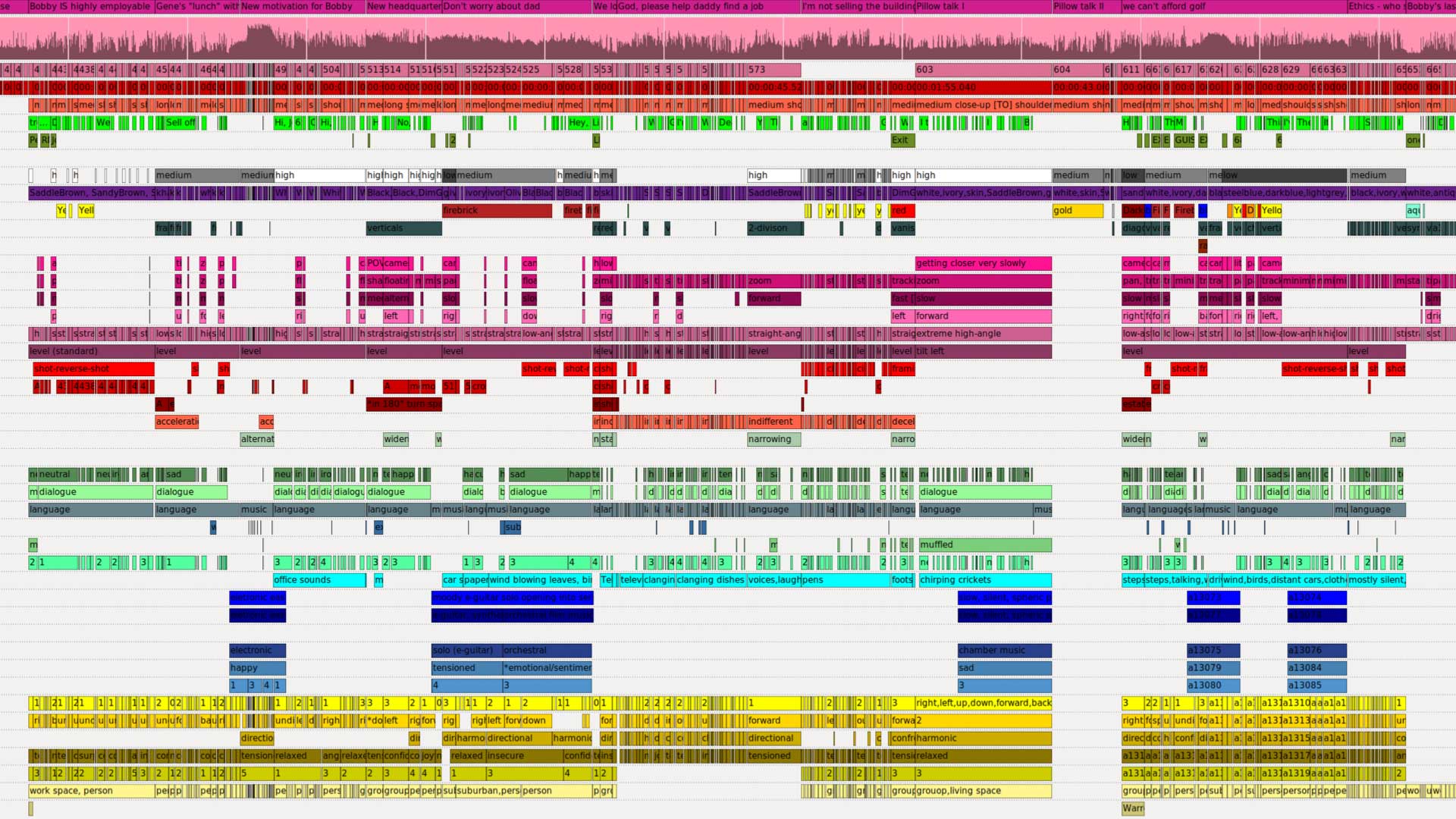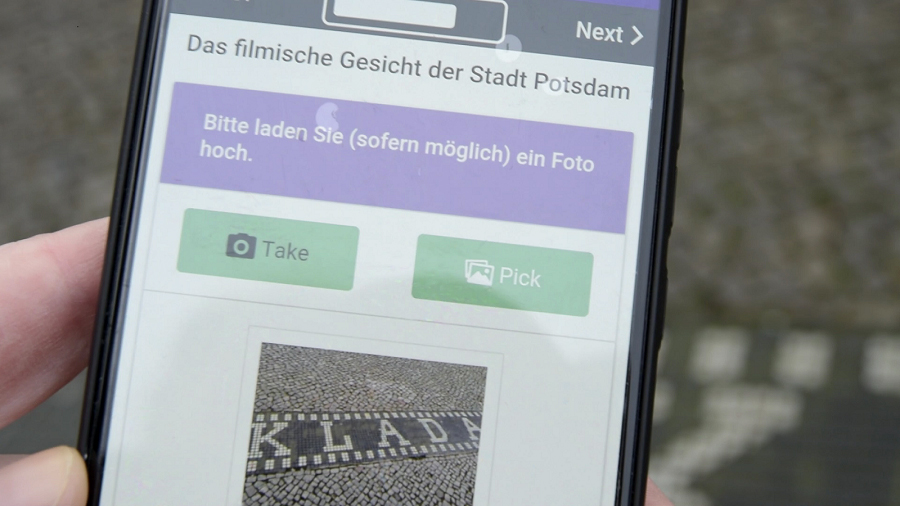- Alena Horbelt
- Maximilian Grenz
- Sarah-Mai Dang
- Matthias Grotkopp
- Franziska Heller
- Anna Luise Kiss
- Eileen Rositzka
- Christina Schmitt
Into the Wild? Film Studies and Transitions into «Openness» (Part 3)
Further Routes of Film Studies and Transitions into «Openness» - Dissemination, Open Data, Citizen Research and Participation
This is Part 3 of a three-part blog entry that recapitulates the conceptual background as well as the six presentations and respective discussions of the online workshop «Into the Wild? Film Studies and Transitions into ‹Openness›»; a workshop which was held as a collaboration between the Center for Advanced Film Studies, Cinepoetics, and the Scholarly Interest Group Open Media Studies in early February 2021.
Here, we give an account on current further routes into openness. Matthias Grotkopp’s contribution critically focussed on open data and data management when publishing annotation data of large audiovisual corpora. The presentation by Anna Luise Kiss on film studies as a predestined field for citizen research and participatory research highlights that openness for and interaction with the public can substantially enrich academic research and vice versa. (For further information on citizen research see Anna Luise Kiss’ three-part OMS blog entry Citizen Science.)
Both Grotkopp and Kiss drew from their own experience with the methods they discussed, while also contextualizing them within the broader field of open research. While Grotkopp’s contribution once again emphasized the impact of the digital for film and media studies’ transitions into ‹openness›, Kiss’ contribution highlighted that ‘openness’ is much more than a (putative) logical consequence of the digital.
The report closes with notes on the final open discussion between all workshop participants.
See the report’s Part 1 for an introduction to the workshop’s concept and aims as well as for a recapitulation of Catherine Grant’s and Sarah-Mai Dang’s contributions to the workshop section «Open Publication I: First Movers».
See the report’s Part 2 for a recapitulation of Franziska Heller’s and Eileen Rositzka’s contributions to the workshop section «Open Publication II: Politics and Practices in Transition».

Fig.1: Annotations in the Advene tool by Jan-Hendrik Bakels, Thomas Scherer, Jasper Stratil, BMBF-Projekt «Audiovisuel Rhetorics of Affect», Freie Universität Berlin 2019, CC BY 4.0
Matthias Grotkopp: Open Data and Data Management – Publishing Annotation Data of Large Audiovisual Corpora
Open data encompasses the practices and structures that make the basic elements of research processes accessible and most of all reusable for the research community and the wider public. In order to achieve that general goal, specific procedures and infrastructures have to be set up for a researcher, a research team or a larger research association.
The German Research Organization (DFG) defines research data as follows:
Research data might include measurement data, laboratory values, audiovisual information, texts, survey data, objects from collections, or samples that were created, developed or evaluated during scientific work. Methodical forms of testing such as questionnaires, software and simulations may also produce important results for scientific research and should therefore also be categorized as research data.1
Within the context of film studies, this includes the collection of audiovisual data presented by archives etc., the metadata referencing specific works (physical and digital), film historiographic sources, data on film economy, exhibition, distribution as well as film analytical annotation data (i.e. the description of specific audiovisual properties). When it comes to structuring research data, it is important to first determine parameters and granularity before creating a vocabulary that is grounded in broad consensus (that is, easily interpretable and also allowing other researchers to relate critically to the analysis and the annotations).
Matthias Grotkopp’s presentation focused on an example from the work of the research project Audiovisual Rhetorics of Affect, for which film-analytical annotation plays a central role. The research team has developed a systematic analytical vocabulary following the requirements of a machine-readable semantic data management, what is known in the data sciences as an ‘ontology’. For this purpose, a simple spreadsheet was used, which was then converted into an ontology according to special specifications of the rdf format, so that information could be articulated as triplets (= A is an instance of B in the category C, «Berlin» is the «capital» of «Germany», «shot x» has «close-up» as its «field-size»). An interface was created between the information and the annotation program: all project members work with the same files, all annotations are saved, and URIs are created automatically. Thus, automatically generated data can be included and corrected afterwards. In addition, the huge output of annotation files becomes more manageable by creating a dynamic visualization. Furthermore, an annotation explorer has been developed, which makes it possible to browse and compare annotations of different films and videos together with the audiovisual files. It is also possible to publish a certain arrangement of films and queries as an URI itself.
According to Grotkopp, the aim should be to treat open data not as an information dump but as an open data ecosystem, where a larger number of researchers and users are able to add, recycle, collaborate, and complement data. The challenge for the future would be to create such a place; as of now, there is no such platform that fulfills all these needs. Moreover, open data only makes sense when approached both from the perspective of producing primary data and with regard to a demand for new kinds of research questions. Descriptive, analytical data in the humanities is never just raw data whatever level of primariness and granularity it achieves, as it is always influenced by theoretical frameworks. One of the disadvantages of film studies as a rather small discipline is that it becomes quite a task to reach a critical mass of content and users to make this service sustainable in the long run. And this would also mean a certain reorientation in terms of questions of originality and creativity in our research process – it still remains an open question whether ingenious observations by individual scholars can come into dialogue and enter a common narrative with such standardized concepts and data objects.
Discussion
There were some comments on the term ‘analytical vocabulary’ saying that one could also refer to this as ‘standards’ or ‘data models’. Also, the reusability of user-generated annotations was discussed, how it can provide a platform for new research questions (big data questions), offer the opportunity to explore the analytical views of other film scholars and to get into dialogue with them.

Fig. 2: The project app Epicollect5 adapted to the citizen science research project «The cinematic face of the city of Potsdam» by Anna Luise Kiss, Filmuniversität Babelsberg Konrad Wolf, 2020, CC-BY-NC-ND, Attribution-NonCommercial-NoDerivatives 4.0 International
Anna Luise Kiss: Film Studies as a Predestined Field for Citizen Research and Participatory Research
For the last presentation of the workshop, Anna Luise Kiss introduced the concept of citizen research. She understands the term not as an independent academic format or a specific research method, but rather as a guiding principle based on the idea of a common production of knowledge. Citizen research does not use citizens as a primary object of investigation like in a survey. Instead, the citizens are active participants of the academic research. On the one hand, this means that they have to be actively involved in the production process of the study and credited for their work. But on the other hand, they also care about the results of the study and benefit from the insight it provides them.
Anna Luise Kiss used her own citizen research project, Das filmische Gesicht der Stadt Potsdam, as an example, where she investigated the phenomenon of film cities as a form of materialized cinematic artifacts. The participants were all locals from the city of Potsdam who explored their own environment and sent her photos of various film-related places and objects. This active engagement gave her valuable insights into details or contexts that she could not have found out on her own. At the same time, the locals took the opportunity to rediscover their own city through a new lens. They were able to get familiar with academic methods and use them for their own interests. In this case, the citizens even started their own research project afterwards.
For citizen research, the process itself should always be as important as the resulting data. Constant interaction between researchers and citizens is required to define goals, develop specific methods, or even create entirely new questions and directions for the study. The researcher should always be open to adapt their approach according to the interests of the citizens, never relying exclusively on preconceived concepts. In this sense, citizen research allows for a self-reflection of academic methods in order to create new ways of generating knowledge and open up the academic field to unexpected forms of interactions with the public.
Discussion
The discussion mainly focused on questions about how to involve different groups of people in citizen research projects. Digital forms of communication (e.g. apps) can be useful, especially to target a younger audience, but the methods applied should always be based on the specific needs of the participants. There is no inherently best way of conducting citizen research, but one option would be to develop such a project in the context of a university seminar. A distinction between citizens and enthusiasts was suggested to better differentiate between the quantity and quality of the participants. Enthusiasts may be more motivated, but they also tend to limit the scope of the investigation to people who have already been interested in the subject before. As a researcher one must find a balance between general marketing and modes of addressing target groups.
Open Discussion
In the final discussion, participants voiced their dissatisfaction with the current state of traditional publication forms. These generally seem to require too much time and money on the part of the researchers without offering them enough in return. In this light, the new possibilities introduced in the presentations were discussed with great interest. However, they were not seen as simply replacing old structures, but rather as a growing set of tools to use for different means. The sheer variety of different forms of communication also opens up a kind of meta-perspective, to reflect about which methodology is best suited for specific scholarly purposes. For example, how much can one rely on the self-evidence of film sequences when they are directly integrated into an academic text as part of the argument? Furthermore, there seems to be a greater need to make one’s own methods and terminology transparent when they are more accessible to a wider audience and have to be transferred between multiple mediums.
An important point was the question of how to acknowledge the various activities of scholars brought about by the aforementioned developments. One way to account for these changes would be the concept of the «sharing factor»,2 which aims at not just evaluating the number of publications by a scholar, but also at giving weight to every other form of activity such as curating or summarizing knowledge for a wider audience. Another big and ultimately open question concerned the financing of the digital infrastructure needed for these new methods of open access.
1. An Introduction & Open Publication I: First Movers. Part 1 of the Report on the Workshop «Into the Wild? Film Studies and Transitions into ‹Openness›»(February 9th, 2021).
2. Open Publication II: Politics and Practices in Transition. Part 2 of the Report on the Workshop «Into the Wild? Film Studies and Transitions into ‹Openness›» (February 9th, 2021).
3. Further Routes of Film Studies and Transitions into «Openness». Dissemination, Open Data, Citizen Research and Participation. Part 3 of the Report on the Workshop «Into the Wild? Film Studies and Transitions into ‹Openness›» (February 9th, 2021).
- 1Deutsche Forschungsgemeinschaft (2019): DFG Guidelines on the Handling of Research Data (https://www.dfg.de/en/research_funding/proposal_review_decision/applicants/research_data/index.html (last retrieved: 2021 03 16).
- 2See Pampel H., Dallmeier-Tiessen S. (2014) Open Research Data: From Vision to Practice. In: Bartling S., Friesike S. (eds) Opening Science. Springer, Cham. https://doi.org/10.1007/978-3-319-00026-8_14
Bevorzugte Zitationsweise
Die Open-Access-Veröffentlichung erfolgt unter der Creative Commons-Lizenz CC BY-SA 4.0 DE.
